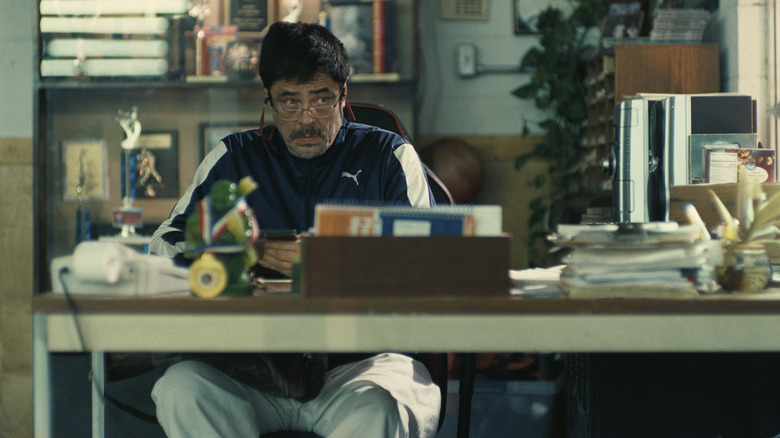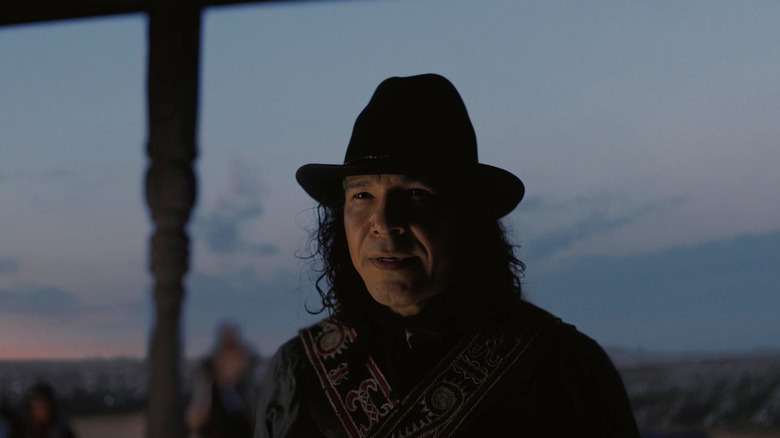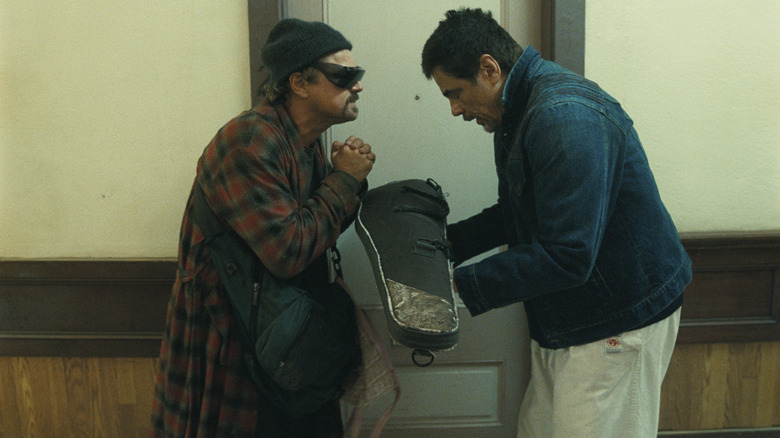One Battle After Another And Sinners Have One Important Thing In Common
This article contains spoilers for "One Battle After Another."
"One Battle After Another" takes many, many liberties with "Vineland," the Thomas Pynchon book that inspired it. However, it does keep some of the novel's central elements, like the generational shift in revolutionary ideas and government administrations squashing resistance.
Pynchon's book shows how Nixon's politics and federal interference sabotaged the 1960s' counter-cultural movements, only for the rampant consumerism and capitalism of the Reagan era to squash any remnant of the '60s' revolutionary spirit. "One Battle After Another" retains some of that, but it's easier to miss the first time around.
That's because the film's migrant detention center-raiding, office building-bombing revolutionary group French 75 is disposed of almost as soon as it's introduced. We see its members issuing loud statements and freeing migrants at a detention center, but they're betrayed shortly after and most of them are executed. As a result, the movie could initially be read as a satire portraying revolutionary groups as little more than angry kids screaming at institutions and throwing explosive tantrums.
Jumping ahead to the present-day, the film then introduces Benicio del Toro's Sergio St. Carlos, a karate teacher and community leader. A nice, quiet man who's undoubtedly disliked by the white supremacists living in his town of Baktan Cross, Sergio is left alone since he doesn't cause trouble or even raise his voice. But there's more to him than meets the eye. You see, Sergio has a "Latino Harriet Tubman situation," offering immigrants refuge and safe passage through the town via a series of tunnels.
Sergio and his allies are the greatest heroes of "One Battle After Another," despite not being in the movie for very long. In that way, the resistance group recalls the Choctaw vampire hunters in "Sinners," who show up for five minutes, make a memorable impression, then immediately leave, never to be seen again.
One Battle After Another and Sinners are both great at world-building
Sergio is very much a peripheral character in the story of Leonardo DiCaprio's ridiculous and hilarious Bob Ferguson in "One Battle After Another." He shows up just long enough to reveal there's a much bigger story happening off-screen, then leaves. (The fact that Anderson doesn't include another scene with Sergio after he's arrested is a tragedy.) The whole thing brings to mind the Choctaws in "Sinners," who show up for a single, short scene yet hint at a conflict that goes well beyond the events of the film.
This is also a perfect example of world-building. It expands the story and setting of "Sinners" in ways that signal to the audience that there are countless events happening elsewhere, as well as characters and history we aren't aware of. The inclusion of the Choctaws also helps place "Sinners" in better historical context by alluding to the real-life history of Native American resistance to white supremacy.
Now, while Sergio's role in "One Battle After Another" is more substantial than that of Chayton (Nathaniel Arcand) and the other Choctaw vampire hunters in "Sinners," it still serves a similar purpose in expanding the movie's scale and scope, introducing a very cool and memorable character, and even alluding to real-world heroes. After all, there are many examples of Latino and Hispanic communities in the United States performing acts of solidarity and resistance against the anti-immigration, anti-Latino wave spreading throughout the country and the horrors perpetrated by the current regime. They might not be flashy, but they're still important and effective.
Sergio is the spirit of One Battle After Another
Sergio is also key to the themes of "One Battle After Another." He represents what resistance looks like in 2025, a time when even the freedom of assembly is under attack and any attempt at peaceful protesting is met with violent suppression by the regime's forces. Sergio's forces aren't trying to escalate things, as they know that will lead to even bigger attacks on their community. Instead, they work quietly under the nose of the authorities. This is how Anderson adapts a crucial idea from Pynchon's book, i.e. the revolution continues with each new generation, even as governments keep trying to stomp it out. The French 75 may've been sabotaged, infiltrated, and betrayed, but its spirit lives on.
Even if one argues that "One Battle After Another" seems to place quieter and more community-oriented activism higher than the violent resistance of the French 75, the movie unequivocally recognizes how violent resistance inspires others. Sergio doesn't help Bob out (even sneaking him out of a hospital after he's arrested) because he teaches his daughter karate. Sergio is specifically inspired to help Bob because he's a former member of the French 75, and "How often do you get to help an original 75 escape?"
No, we don't need a spin-off about Sergio, just like we don't really need a prequel to "Sinners" about the Choctaw. But the fact that they've both sparked such strong reactions from audiences speaks to how effective their roles are in their respective films. And while "One Battle After Another" has made a smaller splash at the box office than "Sinners" did, it's the kind of movie that sticks with audiences long after they've seen it.
"One Battle After Another" is now playing in theaters.


